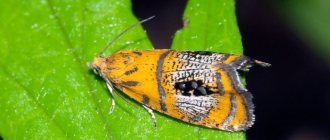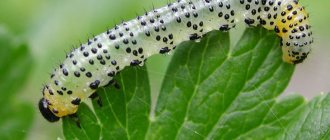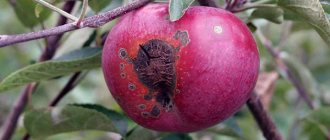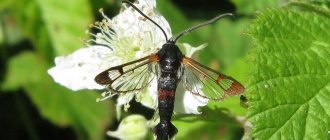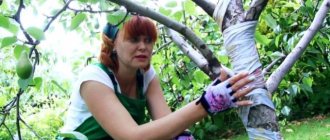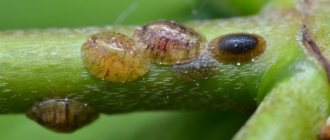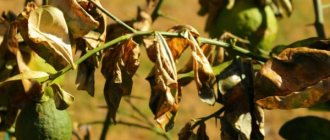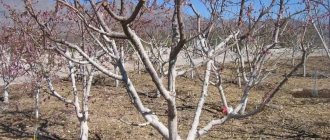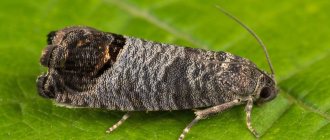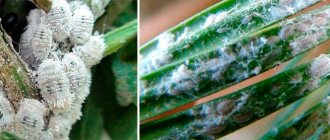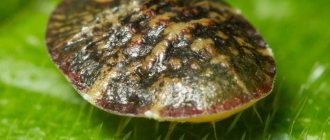» Gardening » Apple tree » How to deal with bark beetle on an apple tree - advice from gardeners
0
1240
Article rating
Fruit trees are often affected by pests, as a result of which gardeners do not receive enough harvest, and the plants often die. Thus, the bark beetle on an apple tree often causes its loss, and in the absence of timely measures taken, the brown sapwood beetle with a striped chitinous shell can destroy the entire orchard.
- Preventive measures
- Let's sum it up
How to deal with bark beetle on an apple tree - advice from gardeners
Characteristics and description of the apple bark beetle
The bark beetle, or as it is also called, fruit sapwood, is a small brown insect. Its body is small, about 4 mm in length, its paws and whiskers are dark brown. Females penetrate into the bark, make many convenient passages in which they lay eggs.
The larvae are small, white, without legs and eyes, but with a very powerful jaw. They develop for a whole year, during which they make passages and holes in the bark of the apple tree and suck out its juices. At the beginning of the next season, they become pupae, and in the summer, full-fledged beetles emerge from them. The summer period coincides with the flowering period of the apple tree.
Very often, the bark beetle pest appears on trees that are weakened or diseased. Moreover, it doesn’t matter whether it’s a young tree or an old one; it equally successfully eats the bark of both.
Why is bark beetle dangerous for an apple orchard?
A small beetle can destroy an entire garden. As a victim, the bark beetle chooses fruit trees that, due to improper or dense planting, have a poorly developed root system and mechanical damage to the bark.
There are times when pests attack a completely healthy apple tree.
Pest larvae eat wood around the entire circumference of the trunk. The nutrition of the tree deteriorates, and infection penetrates through numerous passages. Apple trees die due to lack of nutrients and fungal diseases.
The first signs of damage on a tree
Often gardeners discover the appearance of bark beetle already when the degree of damage is already very high, and more specifically, when the bark comes off in whole layers. Most often, in such a situation, nothing will help the tree; all that remains is to cut it down. That is why it is necessary to know what signs may indicate the appearance of a bark beetle on apple trees. Among them:
- small holes in the bark;
- the appearance of light sawdust or wood flour, evidence of the activity of a bark beetle;
- partial cessation of shoot development;
- a woodpecker settling on a tree, because he really loves to feast on this pest.
Sign of an apple tree being damaged by a bark beetle.
The degree of damage can be understood by the color of flour and sawdust, which can be found near the holes. Brown color means that the pest has just appeared and is still active in the bark, and white means that the process has already moved deeper into the trunk.
Signs and causes of pest appearance
A week after the start of flowering, the bark beetle season begins. At this time they mate and begin to build nests. At first, males become active. They choose a tree and make a tunnel in it.
The insects then attract females by releasing special pheromones. After fertilization, the beetles increase the network of passages. At the end of each branch they lay up to 100 eggs.
The key reason for this process is considered to be a weakening of the culture’s immune system. In such a situation, parasites easily infect the upper part of the tree and settle in its structure. Sick and weakened apple trees are at risk.
The first symptoms of bark beetle infestation include the formation of wood flour. Sawdust appears on the surface of the tree. They are pushed out by the beetles themselves or the larvae by damaging the wood.
When examining the bark, small holes are visible from which rot falls. Based on the color of the sawdust, you can assess the level of damage to the crop:
- brown - indicate damage to the bast or outer parts of the trunk;
- white - indicate serious damage to the trunk.
Additional symptoms of bark beetle attacks include the following:
- The constant appearance of a woodpecker on a tree. It feeds on insects that live in wood.
- Sudden drying and wilting of branches, impaired shoot growth.
- The appearance of holes 2 millimeters in size in the cortex. Gum bleeding is also considered a symptom of the appearance of bark beetle.
- Peeling of bark, exposure of wood with many winding passages. This is the last, most advanced stage, which provokes the death of the plant. It is not recommended to treat such a tree - it must be immediately destroyed.
See also
Description and subspecies of the Antonovka apple tree variety, planting and care rules
Read
Basic methods of control and treatment
There are several options for how to deal with bark beetle on an apple tree. All remedies are good to some extent and only at certain stages. There is a degree of damage when all that remains is to destroy the tree along with the pest.
Insecticides
One of the means of combating bark beetles on apple trees is to spray them with insecticides in the spring and summer. It is important to carry out the treatment in protective clothing, covering the airways with a respirator and wearing goggles.
Spraying is carried out strictly according to the instructions; it is necessary to completely treat the trunk, branches and neighboring trees. Repeat the treatment after a couple of weeks.
Insecticide Calypso.
It is better to choose from this range of insecticides:
- Arrivo. An effective remedy that acts on the pest, penetrating its body upon contact;
- Calypso. The effect of this drug is noticeable within a few hours and lasts for a long time;
- Bitoxibacillin. The drug is safe for beneficial insects, effective against larvae and adults, but not effective against eggs;
- Pirinex. The drug is resistant to external influences and does not lose effectiveness at high temperatures and in the rain;
- Confidor Extra. Highly effective long-acting product;
- Bi-58. A drug that penetrates the beetle's intestines and destroys it.
Almost all of these insecticides act quickly and reliably. However, they have a drawback - they are toxic to tree pollinating insects that fly in the garden during flowering.
Traps and repellers
The simplest bait for bark beetles is freshly sawn wood. Its scent will attract females who will lay eggs there. For such a trap, any piece of branch is suitable, which needs to be placed a little away from the apple tree. After the years of beetles have passed, burn the branch.
Antipheromone repellers are special mixtures of aromas that are made to order by plant pathologists. They come in the form of tapes or tablets. This remedy is effective, but very expensive.
Pheromone trap for bark beetle.
Pheromone traps have the opposite effect. They lure pests to one place and then destroy them. This product is most often used in large gardens.
Syringing
The syringe method is effective only in the early stages of the lesion and can be carried out by specialists using special equipment. The principle of the procedure is to inject a concentrated solution of insecticide into the passages made by the bark beetles. And for the drugs to work, you need to cover the holes with garden pitch. The same means are used as for spraying.
Spraying an apple tree against bark beetle.
Boosting immunity
Most often, bark beetles settle on those apple trees whose immunity is weakened. That is why you need to ensure that the tree is healthy. Here's what will help with this:
- careful but thorough pruning and shaping. It is necessary to ensure that the tree does not receive unnecessary injuries;
- any wounds, cuts, cuts should be immediately covered with garden varnish to prevent pests from getting there;
- water and fertilize the apple tree in a timely manner;
- remove weeds and leaves from the tree trunk in a timely manner.
Proper agricultural technology will help maintain the health of the tree and prevent the appearance of pests.
Drug for increasing the immunity of apple trees HB-101.
You can also use some special preparations to increase the tree’s immunity:
- Rich Micro;
- HB-101;
- Gumi 30.
Substances must be used according to instructions.
Traditional methods
There are a lot of folk remedies that are used to combat the bark beetle. Not all of them are equally effective and require several repeated treatments.
- For 6 liters of warm water you need to use 2.5 cups of carbolic acid and 2.5 cups of laundry soap. Mix everything thoroughly until completely dissolved and dilute in 15 liters of water. Use for spraying.
- Dissolve 50 g of wax, 200 g of sunflower oil and 50 g of rosin in a water bath and mix. Use for sealing passages.
Treating an apple tree against bark beetle with a folk remedy.
It is almost impossible to get rid of the bark beetle without the intervention of chemicals, so it is better to follow preventive measures.
Biological control
If a pest is found on the site, you can collect it manually. This work is quite difficult, because it will be necessary to carefully examine all areas of the bark in order to notice small oval holes. You can also hang bird feeders in the garden. They love to feast on various pests. Woodpeckers, with their powerful beaks, can break through the bark to get to the treasured beetle. When there are more birds on the trees, the number of pests will decrease.
Preventing the appearance of bark beetle in the garden
It is more difficult to destroy a bark beetle than to prevent it from appearing in the garden. For prevention purposes, the following is carried out:
- a thorough examination of fruit trees for violations of the integrity of the bark and weakened branches;
- timely watering and fertilizing of plants;
- sanitary treatment by removing diseased, dead branches, covering cracks, damaged bark;
- whitewashing trunks with lime;
- burning fallen leaves, pruned branches;
- coating the trunks with solutions of clay mixed with humus;
- treatment with drugs that repel parasitic insects;
- digging around tree trunks.
The above preventive measures help prevent the appearance of bark beetle larvae, since it is much more difficult to combat the pest.
Scheme of treatment and prevention with drugs
There is a general plan, following which you can strengthen the apple tree and make sure that bark beetles do not settle on it.
- In the spring, before the buds wake up, whitewashing, sanitary pruning and fertilizing with Diammofoska will be required.
- During the “green cone” phase, watering the tree with Gumi-30 or similar is required.
- When inflorescences appear, the leaves are sprayed with “Bogaty-Micro”, and the trunks and branches are sprayed with Bitoxybicillin.
- At the end of flowering, treatment with Confidor or HB-101 is necessary.
- If a bark beetle appears during the season, you need to clear the passages, spray or douche, and seal the flight passages.
- In the fall, after harvesting, you will need to remove the leaves, trim the branches and whiten the trunk.
These standard procedures must be carried out throughout the season to keep the pest at bay.
Stimulation of apple tree immunity to protect against bark beetle
Weakened apple trees suffer from the bark beetle. The wood of a healthy tree is strong, making it more difficult for beetles to survive and reproduce there. Measures that increase the protective powers of apple trees are carried out to prevent the pest.
Activate the immune system, improve the quality of photosynthesis with the help of “HB-101”. Stages of preventive measures:
- In the spring, seed granules around the perimeter of the tree trunk;
- after flowering, spray the crown 3 times with a solution (1 ml of product per 10 liters of water), an interval of 7 days.
Using the “Rich-Micro” fertilizer, tissues are saturated with microelements. Fertilizing increases resistance to infections and pests. Apply “Rich-Micro Copper + Zinc + microelements”. When preparing a solution, dissolve 1 tbsp in 10 liters of water. l. fertilizers The treatment is carried out per sheet 4 times with an interval of 7 days.
To increase stress resistance, apple trees are watered with Gumi-30 Universal solution once every 2 weeks. Paste (100 g) is diluted in water (200 ml). The concentrate is used to prepare a working solution. For 10 liters of water add 1 tbsp. l.
It is difficult to save a tree affected by bark beetle. Planned preventive treatments of the garden with modern preparations are the best option for combating the beetle.
You need to know the pest by sight
If you notice small dark brown or black bugs in the garden, sound the alarm: the fruit trees have been attacked by a bark beetle. To accurately determine which pest is crawling on your apple tree, catch one individual and examine it with a magnifying glass. It is not difficult to identify a pest that lays eggs under the bark: to remove undigested wood residues, there is a bevel in the back of its body, surrounded by small teeth.
The bark beetle's sense of smell is no worse than that of a sniffer dog. While flying, he finds the smell of the most delicious tree and heads there. The fertilized female gnaws a hole in the bark, penetrates inside and makes many passages to lay eggs there. When larvae form from the clutches, they will begin to actively feed. The food is the tree tissue and its sap. The passages become more branched and wider. The insect secretions contain fungal spores that destroy wood. The infection spreads - the plant withers and may die.
When the young insects come out into the air, they leave the tree where they hatched and look for another plant. Mating takes place there, the female lays eggs, and the whole process continues in a new circle. Over the course of a year, 2-3 generations of wood-damaging pests can grow. If measures are not taken, bark beetles will quickly occupy the entire garden.
Fighting bark beetles using traps and repellers
A harmless and effective way to scare away bark beetles is to use ultrasonic repellers during flight.
An additional method of protecting the garden from bark beetles is to catch insects during flight. In amateur gardening, wooden traps are most often used. For example, after pruning apple trees, the branches are not disposed of, but are stacked away from the site.
The meaning of this procedure is simple: bark beetles navigate through their sense of smell when searching for a new home. The smell of a cut tree attracts insects, and they land not on living plants, but on dead wood. When the flight of the beetles ends (after about 3-4 weeks), this dead wood is burned.
Special antipheromone bark beetle repellers also show high efficiency. These are tablets impregnated with substances that are unpleasant to the smell of insects. It is enough to hang repellers on the branches of apple and pear trees a week before the mass flight to keep bark beetles away from the garden for a long time. The advantage of this product is that it is absolutely harmless to people and the environment. You can buy repellers, for example, at fruit tree nurseries.
Tip #2. It is better not to use pheromone traps, unlike repellers, in private gardens - you can lose all the trees. Pheromones are used only on areas of at least 5 hectares.
